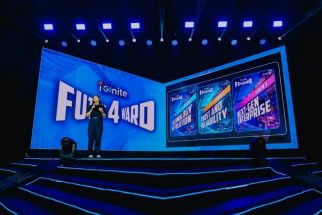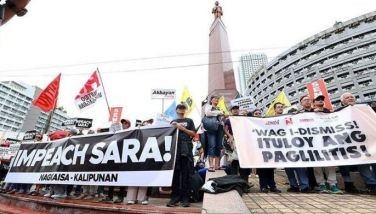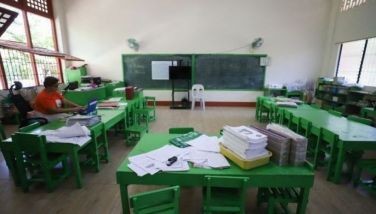Where is Manila Bay’s most polluted spot?
June 5, 2004 | 12:00am
Taking a dip in Manila Bay can be a health hazard, particularly in the Rizal Park waterfront where the water has the highest bacterial count compared with other spots along the bay.
A monitoring report released by the Department of Environment and Natural Resources (DENR) in 2003 showed that the waters in the Rizal Park waterfront area had a total coliform count of 110,550 most probable number (mpn) of bacteria per 100 milliliters of seawater and a fecal coliform count of 22,236 mpn per 100 ml. of seawater.
Both figures are way past the limit deemed by scientists to be safe for humans. Under the DENR’s criteria for waters classified as tourist zones, recreational waters and milkfish spawning areas such as Manila Bay, the acceptable total coliform count is 1000 mpn, while the acceptable fecal coliform count is 200 mpn.
Coliform is a type of bacteria found in the intestines of humans and other warm-blooded animals. The coliform count measures the purity of the water; a high count is a sign of possible pathogenic bacterial contamination.
The total coliform count also includes bacteria that originate from the soil or plants while the fecal coliform count involves only bacteria found in human or animal waste.
These organisms can cause skin diseases in those who swim in coliform-infested waters, or gastrointestinal problems if a person drinks water with a high coliform count. Bacteriologists from DENR explained that the lifespan of coliform bacteria is very short — a matter of days — but they multiply at a fast rate when they can feed on a regular supply of waste matter from highly populated areas.
The monitoring report was released by the DENR’s Environmental Management Bureau (EMB) during a recent workshop on beach environment management sponsored by the World Bank.
The Navotas fishport ranked second to the Rizal Park waterfront, with a total coliform count of 8,775 mpn and a fecal coliform count of 50,075 mpn.
The DENR also found that the waters off Bacoor, Cavite had a high total coliform count of 17,663 mpn and a fecal coliform count of 4,019 mpn.
Other beaches in Cavite that also registered high fecal coliform counts were Lido Beach (1,155 mpn), Villamar Beach Resort (687 mpn), Celebrity Beach Resort (1,719 mpn), Garden Coast Beach (1,880 mpn), Costa Eugenia Beach (1,289 mpn), and Punta Grande Beach (1,289 mpn).
Three beaches located in the Central Luzon portion of the bay also registered high fecal coliform counts. These are Mattel Beach (223 mpn), Villa Leonor beach resort (4,968 mpn), and Barangay Wawa (554 mpn).
"This (condition) has been existing for quite some time. The (report) only validated what we have seen physically," DENR-EMB director Julian Amador said.
"We are continuing the monitoring of this (situation). We don’t have enough time. The results have been sent to the resort owners and other stakeholders in the area. We will then advise them on what to do based on
the findings," he added.
In 1997, hotels and resorts in the world-famous Boracay island in Aklan suffered a 60 percent decline in occupancy rate following a DENR monitoring report that showed a high level of coliforms in the waters surrounding the island.
A monitoring report released by the Department of Environment and Natural Resources (DENR) in 2003 showed that the waters in the Rizal Park waterfront area had a total coliform count of 110,550 most probable number (mpn) of bacteria per 100 milliliters of seawater and a fecal coliform count of 22,236 mpn per 100 ml. of seawater.
Both figures are way past the limit deemed by scientists to be safe for humans. Under the DENR’s criteria for waters classified as tourist zones, recreational waters and milkfish spawning areas such as Manila Bay, the acceptable total coliform count is 1000 mpn, while the acceptable fecal coliform count is 200 mpn.
Coliform is a type of bacteria found in the intestines of humans and other warm-blooded animals. The coliform count measures the purity of the water; a high count is a sign of possible pathogenic bacterial contamination.
The total coliform count also includes bacteria that originate from the soil or plants while the fecal coliform count involves only bacteria found in human or animal waste.
These organisms can cause skin diseases in those who swim in coliform-infested waters, or gastrointestinal problems if a person drinks water with a high coliform count. Bacteriologists from DENR explained that the lifespan of coliform bacteria is very short — a matter of days — but they multiply at a fast rate when they can feed on a regular supply of waste matter from highly populated areas.
The monitoring report was released by the DENR’s Environmental Management Bureau (EMB) during a recent workshop on beach environment management sponsored by the World Bank.
The Navotas fishport ranked second to the Rizal Park waterfront, with a total coliform count of 8,775 mpn and a fecal coliform count of 50,075 mpn.
The DENR also found that the waters off Bacoor, Cavite had a high total coliform count of 17,663 mpn and a fecal coliform count of 4,019 mpn.
Other beaches in Cavite that also registered high fecal coliform counts were Lido Beach (1,155 mpn), Villamar Beach Resort (687 mpn), Celebrity Beach Resort (1,719 mpn), Garden Coast Beach (1,880 mpn), Costa Eugenia Beach (1,289 mpn), and Punta Grande Beach (1,289 mpn).
Three beaches located in the Central Luzon portion of the bay also registered high fecal coliform counts. These are Mattel Beach (223 mpn), Villa Leonor beach resort (4,968 mpn), and Barangay Wawa (554 mpn).
"This (condition) has been existing for quite some time. The (report) only validated what we have seen physically," DENR-EMB director Julian Amador said.
"We are continuing the monitoring of this (situation). We don’t have enough time. The results have been sent to the resort owners and other stakeholders in the area. We will then advise them on what to do based on
the findings," he added.
In 1997, hotels and resorts in the world-famous Boracay island in Aklan suffered a 60 percent decline in occupancy rate following a DENR monitoring report that showed a high level of coliforms in the waters surrounding the island.
BrandSpace Articles
<
>
- Latest
- Trending
Trending
Latest
Trending
Latest
Recommended


































